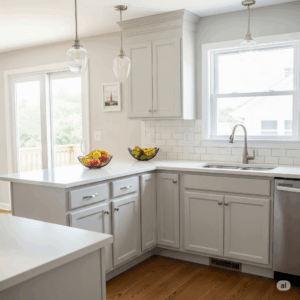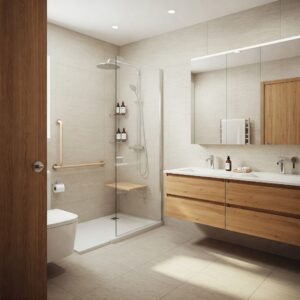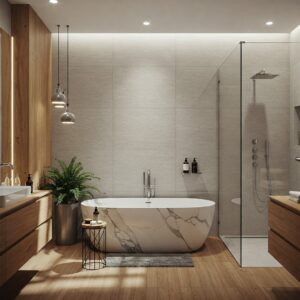As environmental consciousness grows, so does the desire to incorporate sustainable practices into every aspect of our homes, including the bathroom. An eco-friendly modern bathroom beautifully merges contemporary aesthetics – clean lines, simplicity, and functionality – with a commitment to environmental responsibility. This means choosing materials wisely, conserving water and energy, and creating a healthier indoor environment. Far from being restrictive, designing an eco-friendly bathroom can lead to innovative, beautiful, and ultimately more rewarding spaces. This article explores key elements, material choices, and design strategies to help you create your own sustainable sanctuary.
Why Opt for an Eco-Friendly Modern Bathroom? (Benefits)
Choosing a green approach to your bathroom design offers a multitude of advantages:
- Reduced Environmental Impact: Conserves natural resources, minimizes waste, and lowers your carbon footprint.
- Healthier Indoor Environment: Utilizes non-toxic materials and promotes better air quality by reducing off-gassing of harmful Volatile Organic Compounds (VOCs).
- Water Conservation: Incorporating water-efficient fixtures significantly reduces water consumption, lowering utility bills and preserving a precious resource – especially important in many parts of the world, including Indonesia.
- Energy Savings: Energy-efficient lighting and ventilation reduce electricity use, leading to lower bills and less strain on energy grids.
- Durability & Longevity: Many sustainable materials are inherently durable and designed to last, reducing the need for frequent replacements.
- Increased Home Value: Eco-friendly and “green” features are increasingly desirable to homebuyers.
- Supports Sustainable Industries: Your choices can support businesses committed to responsible sourcing and manufacturing.
Key Elements of Eco-Friendly Modern Bathroom Design (Ideas & Trends)
Achieving an eco-friendly modern bathroom involves thoughtful decisions across various elements:
1. Sustainable Material Choices
The materials you choose form the foundation of your green bathroom.
- Countertops:
- Recycled Glass: Beautiful, durable, and made from post-consumer or post-industrial glass.
- Reclaimed Wood: Properly sealed, reclaimed wood offers unique character and diverts waste from landfills.
- Bamboo: A rapidly renewable grass, bamboo is strong, durable, and has a modern appeal. Ensure it’s sourced from sustainably managed forests.
- Durable Quartz: While man-made, some quartz manufacturers have strong environmental certifications and use recycled content. Look for these.
- Recycled Paper Composites (e.g., Richlite, PaperStone): Durable, water-resistant, and made from recycled paper and non-petroleum resins.
- Locally Sourced Stone: Using stone quarried locally reduces transportation emissions (a factor to consider in places like Indonesia with diverse stone resources).
- Flooring:
- Bamboo & Cork: Both are rapidly renewable, comfortable underfoot, and naturally water-resistant to some degree (ensure proper sealing for bathrooms).
- Reclaimed Wood: Adds character, ensure it’s suitable for bathroom humidity and well-sealed.
- Recycled Content Tiles: Many porcelain, ceramic, and glass tiles are now made with significant recycled content. Look for certifications.
- Polished Concrete (if using existing slab): Durable and minimalist, leveraging an existing material.
- Cabinetry:
- FSC-Certified Wood: Wood sourced from responsibly managed forests.
- Reclaimed Wood or Bamboo: Sustainable and stylish options.
- Formaldehyde-Free Plywood/MDF: Choose boards made with no-added urea-formaldehyde (NAUF) resins to reduce off-gassing.
- Low-VOC or No-VOC Finishes: Use water-based paints, stains, and sealants.
- Tiles (Walls & Backsplashes): Similar to flooring – prioritize recycled glass, ceramic, or porcelain tiles with recycled content.
2. Water Conservation
Water is a precious resource; modern bathrooms should prioritize its efficient use.
- Low-Flow Toilets: Dual-flush toilets (offering two flush options) or High-Efficiency Toilets (HETs) use significantly less water per flush than older models.
- Low-Flow Faucets & Showerheads: Look for fixtures with the WaterSense label (in the US) or equivalent local water efficiency ratings. Modern aerators reduce water usage significantly without a noticeable loss in pressure.
- Leak Prevention & Prompt Repairs: Install high-quality plumbing and address any leaks immediately.
3. Energy Efficiency
Reducing energy consumption lowers your bills and environmental footprint.
- LED Lighting: The standard for energy efficiency. LEDs use far less energy and last much longer than incandescent or halogen bulbs. Use them for ambient, task, and accent lighting.
- Maximize Natural Light: Design with large windows (using frosted or smart glass for privacy), skylights, or light tubes to reduce reliance on artificial lighting during the day. Light-colored surfaces will also help reflect natural light.
- Efficient Ventilation: Choose Energy Star rated (or equivalent) exhaust fans. Proper ventilation is crucial for removing moisture (especially in humid climates like Indonesia), preventing mold, and improving air quality, which can reduce the need for energy-intensive dehumidifiers.
4. Healthy Indoor Air Quality
A truly eco-friendly bathroom also promotes a healthy living environment.
- Low-VOC or No-VOC Products: Use paints, primers, sealants, adhesives, and caulks with low or zero Volatile Organic Compounds to minimize the off-gassing of harmful chemicals.
- Formaldehyde-Free Materials: Select cabinetry, vanities, and building materials (like plywood or MDF) made without added formaldehyde.
- Natural Cleaning Products: Opt for eco-friendly, non-toxic cleaning supplies.
- Effective Ventilation: (Reiterated for its health benefits) Good ventilation removes pollutants and moisture.
5. Waste Reduction & Upcycling
Think about the lifecycle of your materials.
- Refinish Existing Fixtures: If your bathtub or sink is in good condition but outdated, consider reglazing instead of replacing it.
- Choose Durable, Long-Lasting Products: This reduces the need for frequent replacements and associated waste.
- Donate or Salvage: If replacing items that are still usable, donate them. Salvage materials during demolition where possible.
6. Bringing Nature In (Biophilic Design)
Connecting with nature enhances well-being and aligns with eco-conscious principles.
- Indoor Plants: Choose plants that thrive in the humid bathroom environment, like ferns, snake plants, orchids, peace lilies, or bamboo. They improve air quality and add a touch of serenity.
- Natural Light & Views: If privacy allows, design for views of nature or ample natural light.
Balancing Eco-Friendliness with Modern Aesthetics
A common misconception is that eco-friendly design means sacrificing style. This couldn’t be further from the truth, especially with modern aesthetics. Many sustainable materials like bamboo, reclaimed wood, recycled glass, and concrete align perfectly with clean lines, natural textures, and the minimalist principles of modern design. The focus on functionality and uncluttered spaces inherent in modernism also complements the mindful consumption aspect of eco-friendly living.
Conclusion
Creating an eco-friendly modern bathroom is an achievable and rewarding goal that benefits both your well-being and the planet. It involves making conscious choices at every stage – from selecting sustainable and non-toxic materials like reclaimed wood, bamboo, and recycled content tiles, to prioritizing water and energy conservation through efficient fixtures and lighting. By focusing on a healthy indoor environment and embracing the natural beauty of sustainable resources, you can design a modern bathroom sanctuary that is not only stylish and functional but also truly responsible.







Leave a Comment